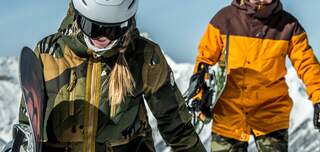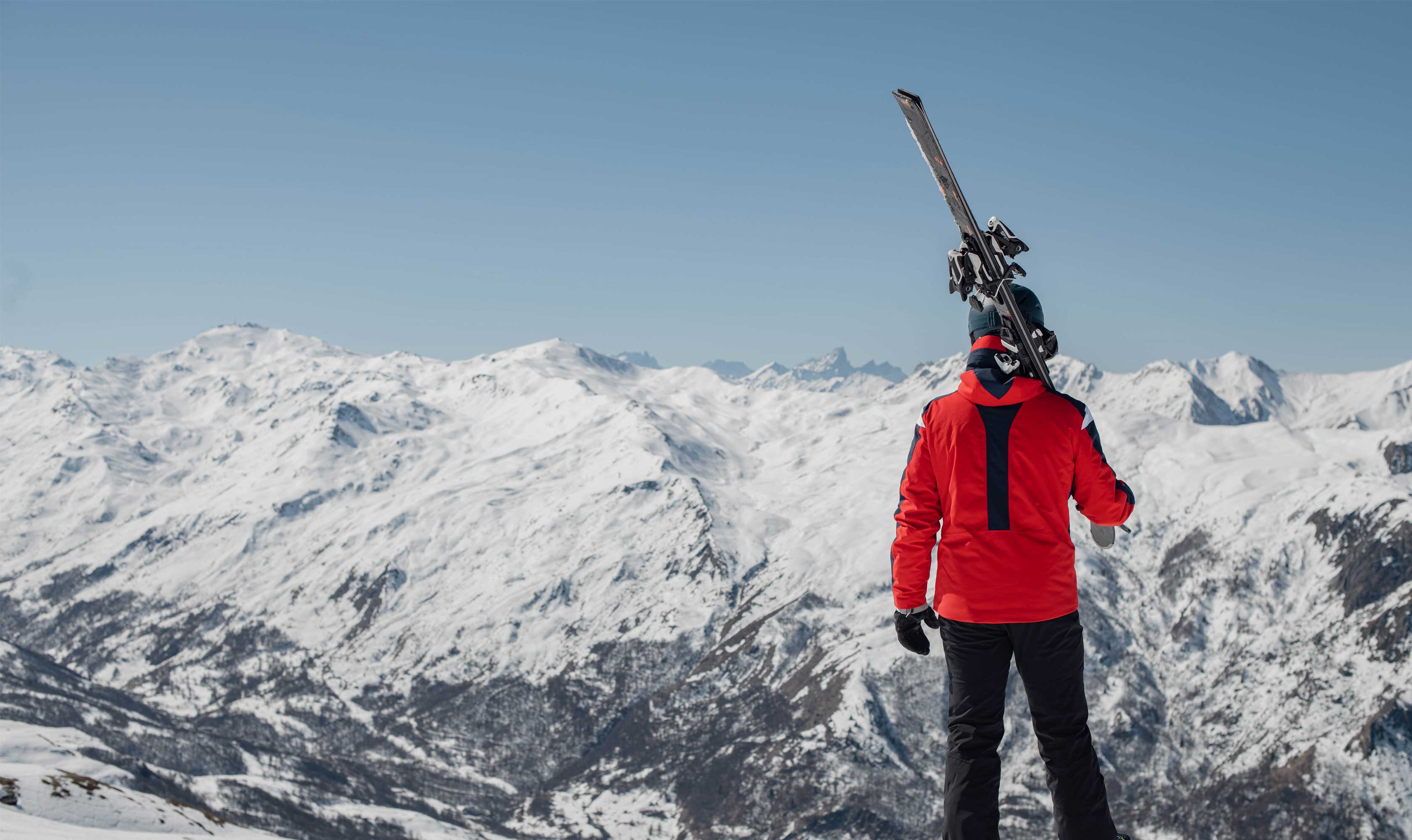SKI AND SNOWBOARD STYLE AND FIT EXPLAINED
Finding the best fitting ski and snowboard clothing is important. Well-fitting clothes provide more warmth and comfort in extreme conditions, and increasingly varied ski and snowboard styles allow individuals to combine fashion and function on the mountain. But with such a huge range of styles and fits available it can be hard to know what is best for you
In this guide, we will help you decode the best ski styles to help you find the best fitting ski and snowboard clothing.
SKI VERSUS SNOWBOARD CLOTHING- WHAT'S THE DIFFERENCE?
When choosing between ski and snowboard clothing, the type of snowsport you do will influence the most suitable gear for your time on the mountain.
Ski clothing is traditionally designed with a slimmer fit. This closer cut helps with heat retention and is thought to improve speed by reducing wind resistance. Ski pants often feature reinforced ankles, which protect against abrasion from sharp ski edges and ski boots. In terms of style, ski fashion tends to favour simpler, block colours for a classic and streamlined look.
Snowboard clothing, on the other hand, is usually looser and more relaxed in fit. This extra room allows for a greater range of movement in both the arms and legs, which is especially useful for the dynamic motions of snowboarding. Snowboard jackets are generally longer, offering more coverage and warmth when sitting on the snow. Snowboard pants are also looser, with extra padding in the knees and rear for added protection and durability during falls or slides.
Key differences at a glance:
- Ski Clothing:
- Slimmer fit for warmth and speed
- Reinforced ankles on pants
- Simple, block colour designs
- Snowboard Clothing:
- Looser fit for freedom of movement
- Longer jackets for more coverage
- More padding in pants (knees and rear)
- Urban-inspired, bold patterns and colours
From a style perspective, snowboard fashion draws inspiration from urban trends, often featuring fun and bold patterns. Ski style remains more traditional but is increasingly influenced by snowboard trends.
Recently, there’s been a growing crossover between ski and snowboard fashion, with looser snowboard-inspired styles becoming popular among skiers. Both types now offer a wide range of patterns and fits, giving you plenty of options to express your style on the slopes.
FIT
When it comes to buying your clothing, it is vital that it fits properly. Poor fitting ski and snowboard clothing is uncomfortable and will not provide the protection you need. Here are some tips on finding the best fit for you.
Jackets
- Arm length: Make sure the arms are long enough. They should finish at the wrist allowing you to use your hands when you’re out and about.
- Shoulders: Ensure that you have mobility in your arms when trying on jacket raise your arms to test the flexibility. The best fitting ski clothing should give you a good range of motion.
- Waist length: This is down to your preference, think about whether you want more coverage with a longer jacket or more flexibility with a shorter jacket that finishes at the hip. Typically snowboard jackets are longer, and ski jackets are shorter.
- Features: Depending on the jacket you can have lots of features like hoods, snow skirts, wrist gaiters and vents. Think about what is most important for you, such as protection or versatility to help make an informed decision.
Trousers
- Length: When buying trousers make sure that you can walk comfortably in them. Longer trousers may get caught in your bindings, causing increasing wear and tear. It is best to try them on with your boots to see if they go over easily and don’t restrict your movement.
- Width: Trousers should fit around the waist comfortably, but should have some room for layers underneath. When trying on trousers it is best to have leggings or thermal underneath so you can get an idea of fit. Lots of trousers now come with adjustable waists for optimum comfort.
- Waistline: Depending on your preferred style there is everything between bib pants to lower rise trousers. High rise provides more coverage and protection, whereas lower or mid-rise trousers offer more flexibility.
- Seams: It is recommended to have covered seams so that moisture cannot penetrate your clothes. Make sure your trousers and jackets are critically or fully taped so you have some level of protection.
STYLE
Now for the style. The style you choose is a very personal preference but across jackets and trousers, there are three different styles you can go with: Slim, Regular and Loose. Each one has their different merits, and the best ski styles are the ones you feel most comfortable in.
Jacket Style
- Slim: Jackets with a slim fit have a more tailored style, being more fitted around the shoulders and waist. Slim fit is recommended for people who want a more flattering cut and want something less bulky and is popular in ski fashion. There are variations in length with some finishing at the hip and others finishing mid-thigh.
- Regular: A nice compromise between slim and loose fit, regular jackets are straighter through the body and usually finish at the hips for maximum comfort and manoeuvrability. This is a good general all-rounder style for both ski and snowboard style.
- Loose: Loose jackets are larger and longer with minimal tailoring. Very popular in snowboard fashion, particularly freestyle and park riders, it allows more freedom of movement in the arms. Looser styles are increasing in popularity, making this a very trendy choice.
Trouser Style
- Slim: A slim fit is more flattering and aero-dynamic as it is fitted at the waist, hips and thigh. Slimmer fit trousers can come with a higher waist which prevents snow and debris from getting in. More tight fitting than other designs these are good for those with the need for speed.
- Regular: The perfect in-between, regular fit trousers are tailored at the waist and the hips with a straighter or flared leg that allows you to wear some layers underneath it, and will fit easily over ski boots. Coming in both mid-rise or high waisted options these are the most versatile style of ski pant.
- Loose: These are straight and usually mid-rise for ultimate comfort. Designs in this category usually combine great urban styles making them a staple amongst boarders and seasonaires looking for comfortable street style.
- Salopettes: Salopettes/Bib pants are classic skiwear items, defined by the over the shoulder straps and high waist. They provide great coverage for your legs and torso. This provides greater protection from the elements and increased warmth. It is also good for freestyle boarders who want to prevent snow getting in after wipe-outs.
Snow Clothing FAQs
Ski clothing usually has a slimmer fit for better heat retention and speed, with reinforced areas for durability. Snowboard clothing is typically looser for greater freedom of movement, with longer jackets and pants for extra coverage and protection when sitting or riding in deep snow.
Snowsports outerwear comes in regular, slim, and loose fits. Regular fit offers comfort and room for layering, slim fit is more form-fitting and stylish, and loose fit provides a baggier look with maximum mobility—popular in snowboarding.
Longer jackets, especially in snowboarding, provide extra coverage when sitting on snow and help prevent snow from entering in deep powder. Ski jackets are often shorter for a sleeker look and improved mobility.
Your jacket and pants should allow enough space for base and mid layers without being too baggy. Regular and loose fits are best for layering, while slim fits may require thinner layers to maintain comfort and mobility.
Look for adjustable hems, cuffs, and waistbands, articulated sleeves or knees for movement, and enough length to cover wrists and boots. These features ensure a secure, comfortable fit and help keep snow and wind out.
Related Articles

Let us know you agree to cookies
We use marketing, analytical and functional cookies as well as similar technologies to give you the best experience. Third parties, including social media platforms, often place tracking cookies on our site to show you personalised adverts outside of our website.
We store your cookie preferences for two years and you can edit your preferences via ‘manage cookies’ or through the cookie policy at the bottom of every page. For more information, please see our cookie policy.











